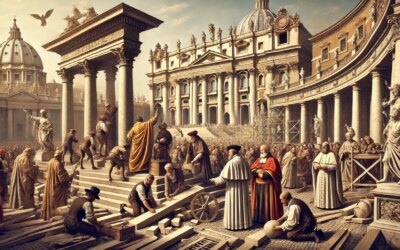Introduction: A Monument to Papal Power
In 1586, the skyline of Rome changed forever when Pope Sixtus V undertook the daring project of relocating an ancient Egyptian obelisk to the very heart of St. Peter’s Square. The effort was not just a technical triumph—it was a statement of spiritual authority and urban renewal. Standing at over 25 meters tall, the Vatican Obelisk remains one of the most iconic features of the piazza and a symbol of the Catholic Church’s enduring vision during the Counter-Reformation.
From Ancient Egypt to Imperial Rome
The obelisk originated in Heliopolis, Egypt, and was brought to Rome by Emperor Caligula in 37 AD. It originally stood in the Circus of Nero, where early Christians, including Saint Peter, were believed to have been martyred. Over time, the monument was partially buried and neglected, a silent relic of Rome’s imperial and pagan past. Sixtus V sought to reclaim and Christianize this ancient artifact as part of his sweeping program of urban reorganization.
Pope Sixtus V and His Vision
Sixtus V, born Felice Peretti, was a reforming pope with bold ambitions. His short pontificate (1585–1590) was marked by dramatic infrastructure projects: aqueducts, roads, churches, and obelisks. He envisioned Rome as the physical embodiment of Christian glory. By placing the obelisk at the center of St. Peter’s Square, Sixtus aimed to link Christianity’s spiritual authority with the engineering might of ancient Rome.
The Engineering Challenge
Moving a 350-ton obelisk was no small feat. The task was assigned to architect Domenico Fontana, who assembled a team of 900 workers, 140 horses, and a forest of ropes, pulleys, and wooden towers. The operation began on April 30, 1586, and lasted until September 10. The Vatican ordered absolute silence during the final raising—breaking it only when a sailor famously shouted to wet the ropes to prevent snapping, saving the operation.
Symbolism and Ceremony
When the obelisk was finally erected, it was crowned not with a Roman eagle, but with a bronze cross containing a relic of the True Cross, symbolizing Christianity’s triumph over paganism. The moment was commemorated with celebrations and a papal blessing. For Sixtus V, the obelisk was not just a monument—it was a cosmic axis linking heaven, earth, and the authority of the papacy.
Impact on Urban Rome
The relocation of the Vatican Obelisk set a precedent for the redesign of Rome’s cityscape. Sixtus V positioned obelisks at key intersections and pilgrim routes, transforming the Eternal City into a sacred topography. These monuments served as navigational aids, devotional centers, and visual markers of papal power, making them central to the experience of Rome during the Counter-Reformation.
Legacy of the Vatican Obelisk
The obelisk remains a focal point of St. Peter’s Square, drawing millions of visitors and pilgrims each year. Its placement and alignment with the basilica’s façade were later echoed in the square’s Baroque redesign by Gian Lorenzo Bernini. Today, the obelisk stands as a bridge between ancient heritage and Christian tradition, a testament to Rome’s ability to reinvent itself through every epoch.
Conclusion: A Stone That Speaks Across Time
The erection of the Vatican Obelisk under Pope Sixtus V was more than a logistical miracle—it was a profound act of spiritual and cultural synthesis. By claiming an ancient imperial symbol and placing it at the epicenter of the Christian world, Sixtus reasserted Rome’s role as the eternal city—not just of Caesar, but of Christ. In the obelisk’s shadow, centuries of history converge into a single vertical line pointing toward heaven.



